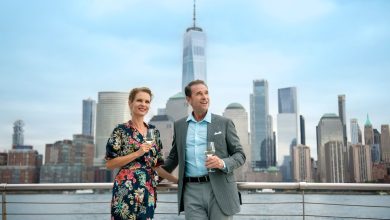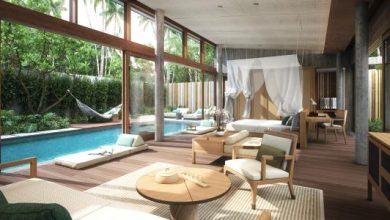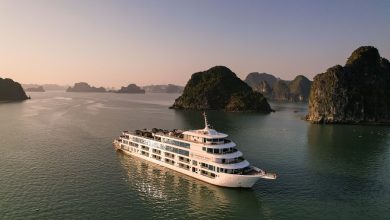VIKING POLARIS CRUISE DELIVERS MORE THAN ADVENTURE
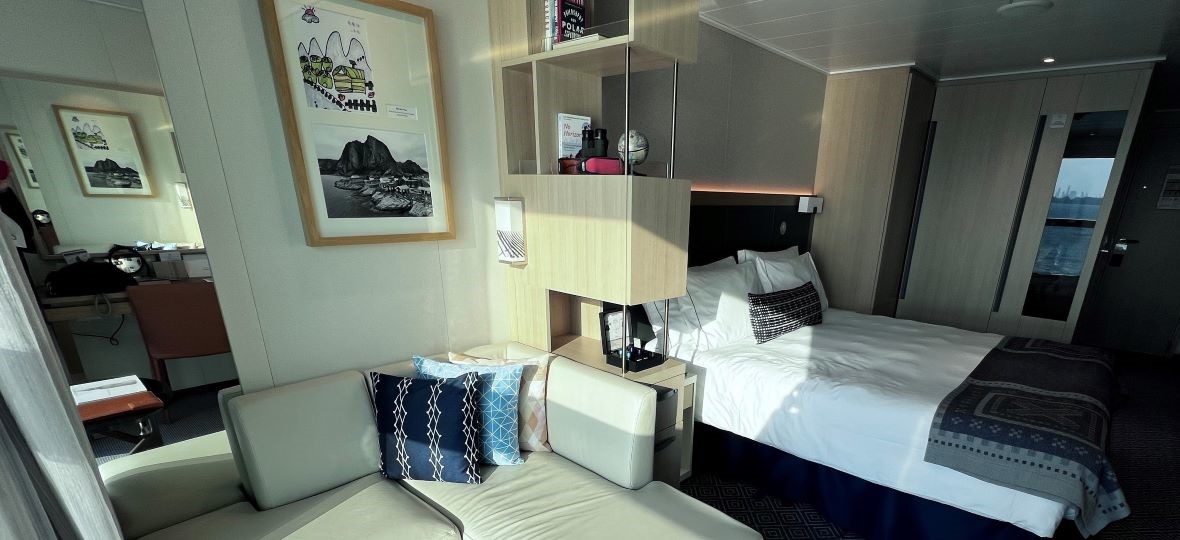
Excitement flew high on the Atlantic breeze as we stood on the top deck of Polaris, counting seconds for the meteorologist to untether the massive weather balloon. As the helium-filled bubble soared 30 kilometers into space and out of view, everyone cheered, thrilled to witness the scientific mission, synchronized with weather stations around the globe, to simultaneously launch balloons to gather crucial atmospheric data for predicting weather.
By now, we knew our Polaris cruise bestowed value beyond adventurous escapades and delicious meals. As one of Viking’s two 378-passenger expedition ships, Polaris and her identical twin, Octantis (launched months earlier in 2022), are purpose-built with Polar Class 6 technology and stabilizers to navigate through harsh icy waters in remote Arctic and Antarctic conditions. Meantime, both operate as fully equipped scientific research vessels with a 256-member crew, including about 30 scientists who happily engage passengers to participate in research along the way.
Arriving recently at Toronto Harbour to see Polaris’ jaunty prow facing the city skyline across sparkling Lake Ontario, my anticipation rose for the 16-day ‘Canada and Atlantic Coastline’ itinerary that would traverse the St. Lawrence Seaway enroute to Fort Lauderdale.
Mingling with passengers in the small cruise terminal, I was surprised to learn that several couples who hailed from Calgary, Mississauga, or Ontario towns – all who spend winters in Florida – had been inspired to book this itinerary by savvy travel advisors who recommended it as “a leisurely cruise alternative to flying south.” Two couples from New Zealand said their advisor suggested this as part of a North America tour – starting with flights to Vancouver, Calgary, and Toronto “to see Niagara Falls” – that would continue inland from Fort Lauderdale.
Minutes after embarking, we were ushered to a safety briefing. An expedition crew member demonstrated the ease of donning the emergency life jacket. With its attached life preserver and protective, head-warming hood, the zip-up jacket is the most impressive emergency apparel afloat.
Home away from home at sea
On to my home at sea: Polaris staterooms run from 21 sq. m. to spacious 110. My minimalist room #3011 proved comfortable, cozy, and bright for the entire voyage. The corner seating area converts to a “Nordic balcony” with the press of a button that raises and lowers the window. A narrow observation shelf is handy for balancing a camera or supplied binoculars. Amenities include a stocked mini-fridge and Nespresso maker. The comfortable bed has fluffy goose down pillows, though hypo-allergenic bedding is available on request. The compact bathroom has heated floors and towel rail, double sink, stall shower, and Freyja toiletries.
A full-length drying closet holds expedition life preservers (lighter that emergency jackets) used for kayaks and Zodiac tours. On Arctic and Antarctic itineraries it conveniently airs out polar gear including the Viking-supplied keepsake parka, waterproof pants and loaner boots. I used it to dry small items rinsed in the sink. Incidentally, on this southern coastal route, I loved my starboard-facing location for landscape views.

Windows on the world
Exploring Viking Polaris’ six decks, it was evident the ship is architecturally crafted for viewing nature in any destination, any elements, as outdoor areas include protective. Facing forward on Deck 3, The Bow is perfect for viewing approaching ports, while The Shelter provides cover. Indoors, lofty views are visible from the panoramic Explorer’s Lounge. Overlooking the wake at aft or back-of ship, Finse Terrace seats are positioned around a lava stone fire pit. Aft views are also seen on Deck 5, from the al fresco Aquavit Terrace, or two small pools, including one with a retractable glass roof.
Interior spaces have vast windows, inviting the outdoors in. On Deck 5, Viking’s Nordic styling induces a sense of sumptuous comfort in The Living Room and The Library. Leather sofas draped with reindeer hides and Scandinavian wood chairs are artfully clustered with contemporary accents for congenial mingling. Cushy chaises piled with pillows in tactile fabrics invite serene repose for writing a journal, or reading one of Viking’s zillion books. Games tables with built-in technology promise endless fun. For all its restful environment, I imagine passengers jumping at the sight of breaching whales, grabbing cameras, and dashing to the outdoor promenade.
Lower decks showcase Viking’s dedication to enriching passengers’ environmental awareness with mindful experiential activities, and why the line is dubbed “the thinking person’s cruise.” Expedition Central has charts, maps, a model weather balloon, and computers to research the local biosphere. The Studio has life-size models of local birds to help identify species. The Lab – Polaris’ scientific research facility – is where passengers get hands-on experience analyzing specimens collected on tours.
Up on The Bow for the “Champagne sail-away” from Toronto Harbour, passengers raved about the city I take for granted. Mingling with people from Washington, New York, and Copenhagen, I learned they were among 33 who embarked in Duluth, Minnesota, for a Great Lakes cruise. Turns out, they’re on the second segment of Viking’s Longitudinal World Cruise, continuing beyond Fort Lauderdale, through the Panama Canal, along South America to the Galapagos and Chilean Fiords, enroute to Ushuaia for an Antarctica expedition.
Expedition briefing
After the CN Tower drifted from view, we headed to the first of daily briefings in The Aula. The beautiful, light-filled amphitheatre was inspired by the University of Oslo’s venue for the Nobel Peace Prize. Captain Xavier Mongin introduced the international crew including submarine pilots, kayak and Zodiac drivers, and mountain guides. They invited passengers to meet in The Hangar the next day.
Chief Scientist Dr. Brandi Revels gave our voyage environmental context when she said: “We are on the same journey as all the water in the Great Lakes that flows to the ocean. This cruise excites our scientists studying changes in the coastal biosphere. They are experts in marine biology, nuclear chemistry, meteorology, ornithology, whales, or Great Lakes ecology.”
Their ambitions include launching underwater video systems along the way to study fish migration and monitor the flow of microplastics; and gathering phytoplankton specimens to track changes in ecosystems. Interestingly, Viking partners with global research institutes, including NASA Global Cloud Watch, and National Oceanic and Atmospheric Association (NOAA) which receives atmospheric data from weather balloons. Dr. Revels said learning about nature and cultivating nature hobbies nurtures the mind.
Briefing over, passengers headed to dinner, most to buffets at World Café (for international dishes and seafood) or Mansen’s (for Scandinavian specialties). Polaris’ two restaurants require reservations. Manfredi’s serves Italian specialties, and The Restaurant, international cuisine. Tucked at a scenic window table in Manfredi’s, I relished every taste of my salad sprinkled with peanuts and pecorini cheese; fragrant porcini mushroom soup; tasty rack of lamb with truffle ragu polenta; and green tea sorbet. Dining solo, I appreciated the staff’s engaging attention, particularly the chef who greeted people at every table by name.
Thousand Islands cruising
Early next morning, beaming sunshine sparked a lively atmosphere as Polaris navigated eastward through the Thousand Islands. Passengers lining The Bow poised cameras and binoculars, ready to capture wildlife, eagles’ nests perched on trees, and flocks of sea birds nestling on shores of tiny islets. Others walked the promenade, exercised in the gym, indulged in the spa, or simply relaxed.
Along the way, a scientist detailed the importance of the Great Lakes and the St. Lawrence River as an historic artery for exploration and trade long before Canada or the US achieved nationhood. Completed in 1959, construction of the 306-km. stretch of St. Lawrence Seaway between Montreal and Canada was considered one of the world’s most challenging engineering feats. Seven locks were built to raise vessels 75 m. from sea level at Montreal as they transit to Lake Ontario’s elevation. At its eastern point, The Seaway officially starts at Lake Erie where it links to Lake Ontario via the Welland Canal locks built in 1932. On our eastward path, the locks would lower Polaris’ elevation, starting at the US-owned Eisenhower and Snell locks enroute to five Canadian locks.
Stopping for lunch in the World Café, I found abundant choices including filet of beef, lamb chops, lobster, sea bass, pastas, salads, and tempting desserts. Figuring on tempering my appetite, I vowed to take steps instead of elevators.
Yellow submarines
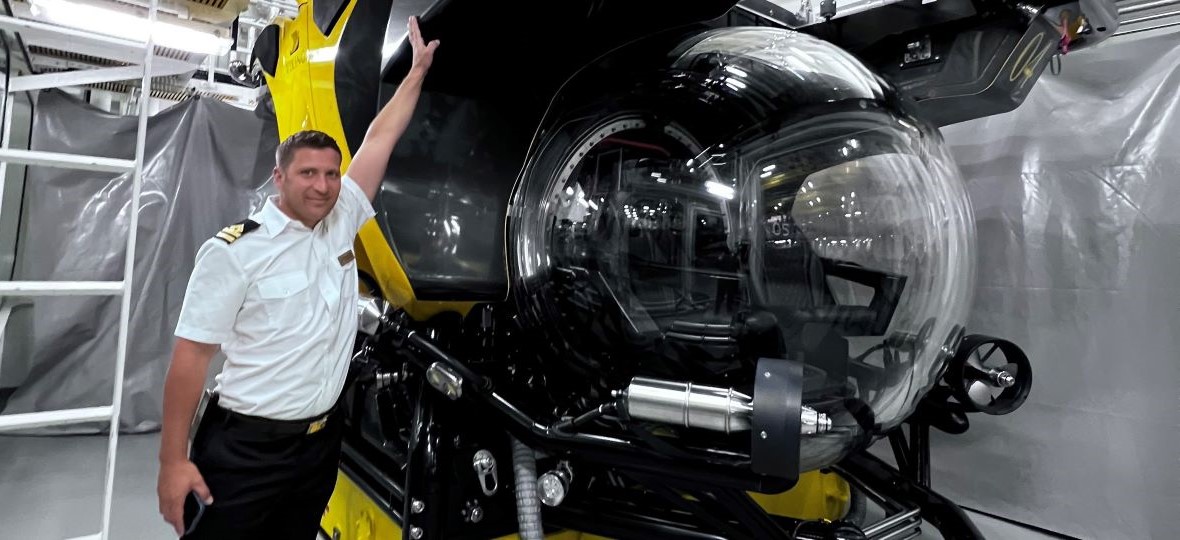
That afternoon, I visited the enclosed marina called The Hangar, eager to see the two yellow submarines, which I’d been hesitant to pre-book for excursions. My confidence revved up as 2nd Officer Submarine, Nikola Marinovic explained the submarine’s 270-degree spherical bubble virtually “disappears” as it descends, giving the six passengers seated on swivel chairs the sensation of total immersion. Standing beside the duo – named Ringo and George – Marinovic showed the submersion level when passengers board it from a Zodiac. Inspired, I ran to the excursion desk, only to make the wait list. Space was available on the SOBs, the two military-grade Special Operations Boats that seat 12 for scenic tours.
Next morning, while Captain Mongin navigated toward Trois-Rivieres, expedition photographer Molly Wallis gave tips on iPhone photography. She promised to take photos along the way, and post images on the ship’s app that passengers could download.
Viking includes guided tours in every port where possible. When Polaris berthed alongside Terrace Turcotte, passengers had various options. Active types joined kayak safaris, SOB jaunts or a rural hike. Others toured Trois Rivieres’ historic Old Town. Established in 1634 as a settlement of New France, it was strategically positioned for fur traders and explorers. Sites included Notre-Dame-du-Cap Sanctuary, the cobbled street of Ursuline Nuns, the infamous Old Prison now linked to the modern POP Gallery, and lively Rue de Forges, lined with shops and cafés.
Back on Polaris, we snacked on bowls of French-Canadian pea soup at Mamsen’s. At the daily briefing, the marine ecologist described how passengers helped deploy equipment to measure the transition of Great Lakes waters to Trois Rivieres’ marine environment. Later that evening, a lecture on Quebec City prepared us for the next day.
In Quebec City, Viking offered premium (extra cost) excursions to Montmorency Falls & Ile d’Orleans, and Cap Tourmente National Wildlife Area. The included walking tour of Old Quebec City provided an excellent overview of the UNESCO World Heritage Site, plus the Saint-Louis Forts and Chateaux excavations led by engaging Parks Canada guide, Gabrielle Baltan.
Along the way, I met two, different solo passengers who became lovely ship-board friends. Both heading to Antarctica, one was on her third world cruise, the other on her eighth.
Atlantic Canada
Cruising into the Gulf of St. Lawrence next morning, we spotted the first of the string of Canada’s iconic lighthouses that lit the way for early sailors and fishermen. Lectures focused on the St. Lawrence River, third largest in North America. Historically, on the First Nations people who originally inhabited its shores, explorer Samuel de Champlain, and the evolution New France and Quebec City. Science buffs were enthralled by details and images of the river’s diverse ecosystems, its species of plants, fish, and birds.
I dedicated my afternoon to wellness in the spa, vacillating between the hot steam room, frosty snow room, and swimming against waves in the long therapeutic pool. Loving the sensation, this became part of my sea day routine.
Brilliant skies the next day enhanced thrilling jaunts around Iles-de-la-Madeleine. Actives exploring by kayaks, Zodiacs or SOBs came close to playful seals and sea birds nestled along rugged red cliffs. Others tendered to Cap-aux-Meules for a culinary hike of Belle-Anse to taste local seafood and cheese. Or enjoyed oyster tasting on a scenic tour with stops at the L’Etang-du-Nord lighthouse, famed fishermen statue, and early Acadian settlements, including precious La Verniere Church, North America’s second-oldest wood church, circa 1872-1891.
Excitement was palpable for submarine dives when Polaris anchored near Cape Breton, NS, near Canada’s oldest lighthouse guarding Fortress Louisbourg. Hopes fizzled when the sub team decided the combo of northerly winds with 1.5-metre southerly swells made boarding too risky. Instead, sub participants boarded watercraft, and returned with amazing shots of hawks and cormorants.
Submarine excitement rose again when Polaris anchored near Lunenburg, NS. When the sub team started their trial descent, they found the water too murky for visibility. Meantime, watercraft were ready, as were Lunenburg’s delightful options. The historic Old Town is a UNESCO World Heritage Site, hailed as North America’s best surviving example of British colonial settlement. Eager to revisit Peggy’s Cove after many years, I joined the premium (extra cost) tour with lobster lunch. The lobster could have tasted better, but seeing the lighthouse perched on the stony cape was priceless, and I was pleased to see the new viewing platform for people with mobility issues.
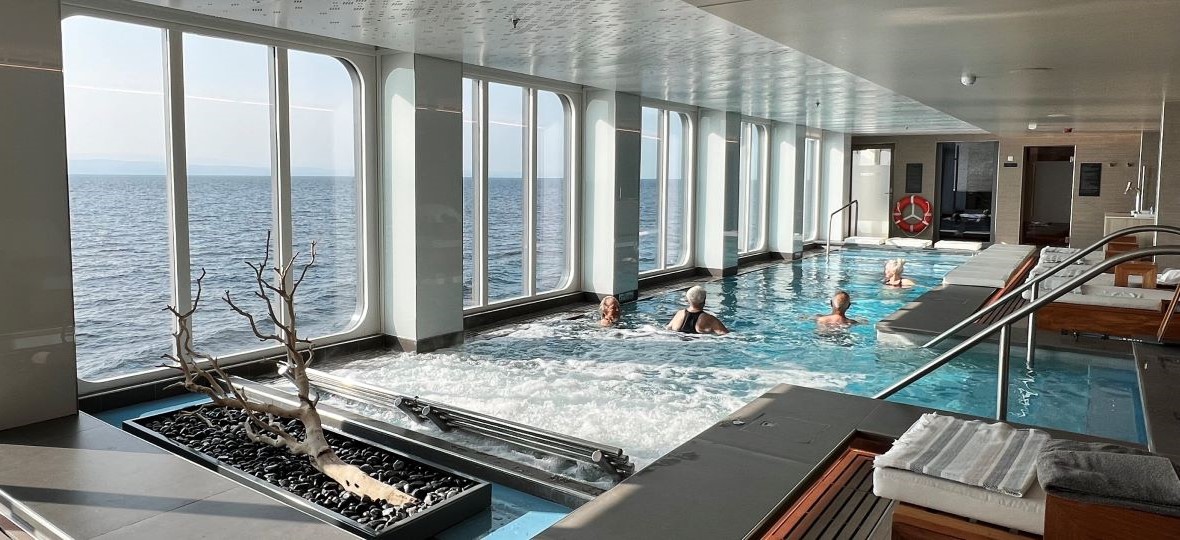
Wildlife galore
Wildlife viewing was spectacular the next day, as we passed Halifax and entered the Atlantic Ocean. Pods of dolphins followed us for miles. Minke whales arched out of the ocean, and dove with flashing tails. Among flocks of seabirds, a pair of wide-winged Peregrine falcons followed Polaris. When the wide-winged male caught a small bird of prey, he perched on the ship’s rail, and squawked at nearby crew to stay away.
New York, New York
Everyone rose before dawn the next morning for the sensational approach to New York Harbour. Passengers lined The Bow in darkness – warmed by hot Baileys Cream coffees – as we passed the gleaming Statue of Liberty, entered the Hudson River, and cruised along the dazzling skyline to our Pier 88 berth in the heart of the city.
Viking’s included excursions included the 911 Memorial and Museum, the Museum of Natural History, plus an all-day complimentary shuttle. The premium “Evening City Lights” tour included a visit to the top of the Empire State Building.
Virginia and South Carolina
Leisurely sea days separated the next two ports of call. Norfolk, Virginia and Charleston, SC, each gave wonderful opportunities for watercraft adventures, plus varieties of guided tours to historic and cultural sites, including pre-Civil War plantations. As the world’s largest naval base and headquarters of the US Navy Atlantic fleet, Norfolk awed history buffs as we cruised past reams of massive battleships poised to deploy. Charleston charmed passengers with its elegant parks, wealth of meticulously preserved colonial architecture, and an intimate visit to a lavishly decorated antebellum mansion.
Bon voyage
By the last sea day enroute to Fort Lauderdale, Polaris’ atmosphere felt like a convivial community. As a solo cruiser, I’d met engaging couples along the way. On their first cruise, Americans Michel and Wayne Stuart – she an efficiency engineer professor, he an orthopaedic doctor who had set up medical school facilities in Peru, Tanzania, and India – told me they loved travelling to “dig deep into the culture of a place.” They “loved participating in Polaris’ science research” and “experiencing culture in places we can’t visit on our own.”
Charmian Kinner and Patrick O’Reilly – who’d met while travelling in Europe – were on their third world cruise together, this time to step on their fifth continent, Antarctica. Both active couples described “spectacular” submarine dives in the Great Lakes and planned future dives in Caribbean waters. As for the Polaris vessel itself, each couple described it as “perfect for us.” What they loved best? Polaris’ small size, casual ambience, abundant meals, and friendly crew. I agreed.
Details:
Viking’s “all inclusive” expedition cruises include dining in all buffets and restaurant; wine, beer and soft drinks at lunch and dinner only; use of all thermal spa facilities and fitness equipment; watercraft excursions by Zodiac, kayak and SOB (Special Operations Boat); and guided excursions in most ports. Submarine dives cost US$499 p.p..
Viking’s 16-day ‘Canada and Atlantic Coastline’ itinerary is a segment of the Longitudinal World Cruise that starts with a Great Lakes cruise and culminates in Ushuaia for an Antarctic expedition.
In 2024 and 2025, the 61-day Longitudinal World Cruise will depart from Milwaukee in the Great Lakes.
First published at Travel Industry Today


